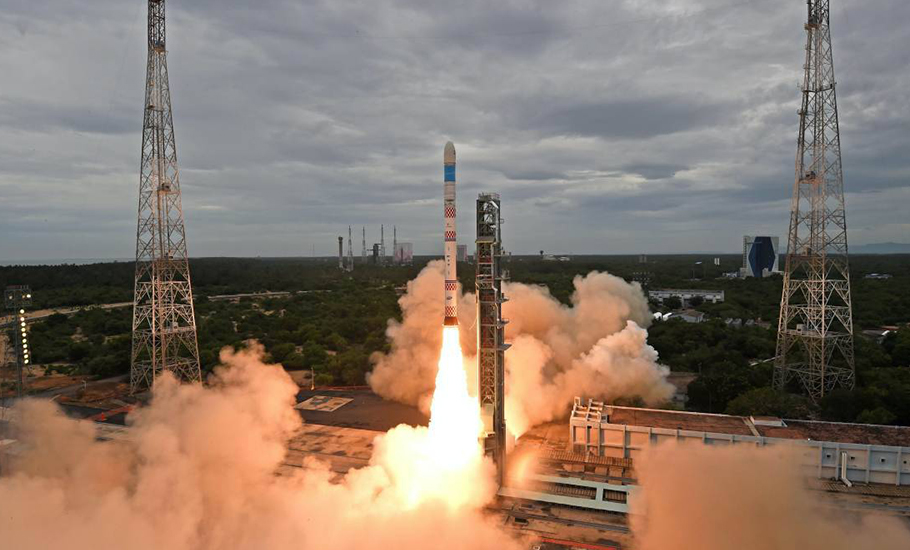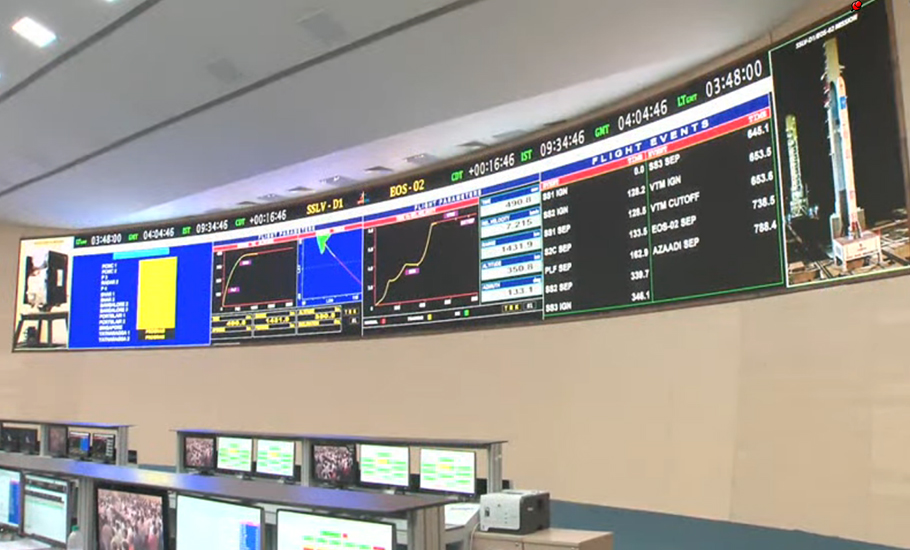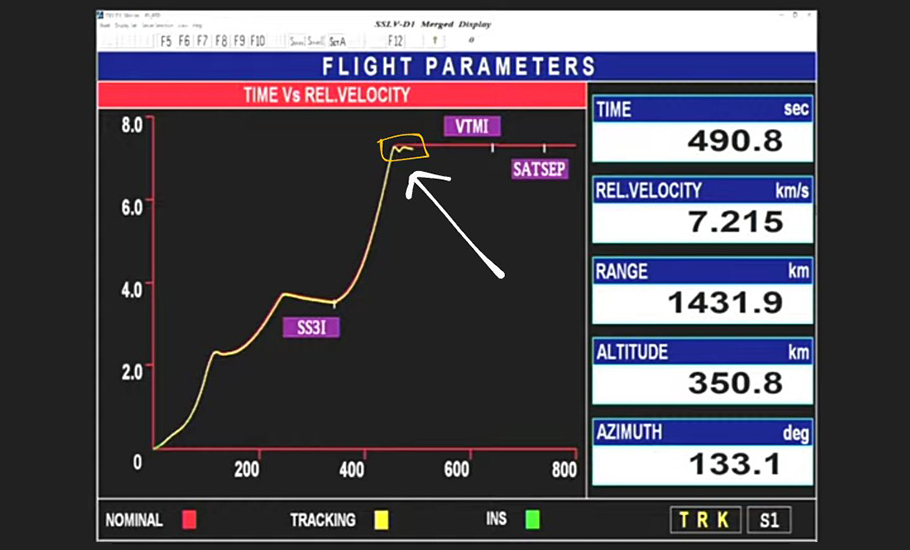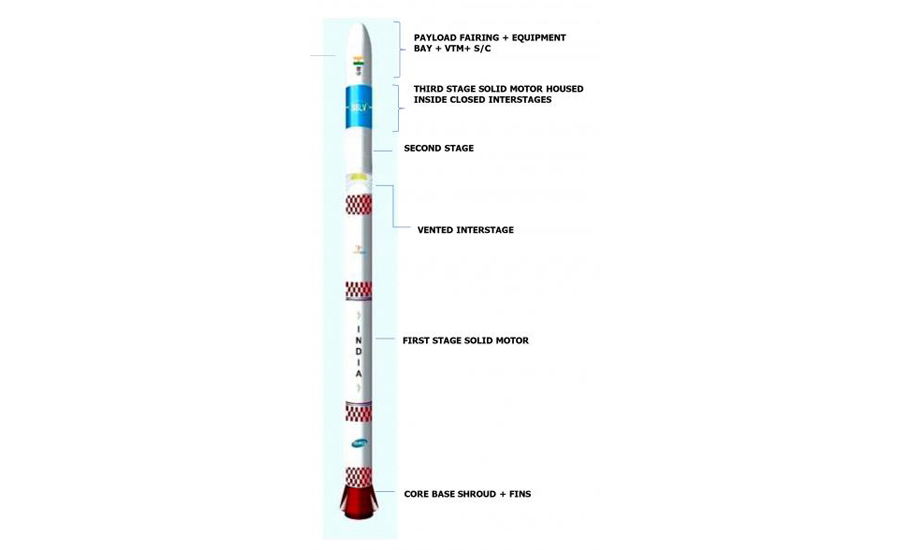
- Home
- News
- Analysis
- States
- Perspective
- Videos
- Education
- Entertainment
- Elections
- World Cup 2023
- Features
- Health
- Business
- Series
- Economy Series
- Earth Day
- Kashmir’s Frozen Turbulence
- India@75
- The legend of Ramjanmabhoomi
- Liberalisation@30
- How to tame a dragon
- Celebrating biodiversity
- Farm Matters
- 50 days of solitude
- Bringing Migrants Home
- Budget 2020
- Jharkhand Votes
- The Federal Investigates
- The Federal Impact
- Vanishing Sand
- Gandhi @ 150
- Andhra Today
- Field report
- Operation Gulmarg
- Pandemic @1 Mn in India
- The Federal Year-End
- The Zero Year
- Premium
- Science
- Brand studio
- Home
- NewsNews
- Analysis
- StatesStates
- PerspectivePerspective
- VideosVideos
- Entertainment
- ElectionsElections
- Sports
- Loading...
Sports - Features
- BusinessBusiness
- Premium
- Loading...
Premium

SSLV-D1 failed, but what's next?

The maiden launch of a small satellite launch vehicle (SSLV) failed in its objective of placing the AzaadiSAT in the prearranged orbit. Nearly 750 schoolgirls, ten from 75 government schools, were coached by ‘Space Kidz India’, a non-governmental organisation promoting science and technology education among girls, to build the nanosatellites. Despite the setback, the schoolgirls...
The maiden launch of a small satellite launch vehicle (SSLV) failed in its objective of placing the AzaadiSAT in the prearranged orbit. Nearly 750 schoolgirls, ten from 75 government schools, were coached by ‘Space Kidz India’, a non-governmental organisation promoting science and technology education among girls, to build the nanosatellites. Despite the setback, the schoolgirls are strong; they are proposing to be persistent, knowing very well that there are no failures, only opportunities to learn in science.
The primary payload, the Earth Observation Satellite (EOS-02), also failed to reach orbit. The mission was also expected to dramatically unfurl the Indian flag in space, to mark the 75th anniversary of India’s Independence.
Due to a software bug, the rocket’s fourth stage, the liquid propulsion-based Velocity Trimming Module (VTM), malfunctioned, resulting in the injection of these payloads into an unstable orbit. Both the satellites it is predicted have fallen into the Pacific Ocean.
Ill-fated SSLV-D1
SSLV D1 is the first test mission of the three plus one terminal stage rocket, SSLV, developed recently by the Indian Space Research Organisation (ISRO). The unique augment to the launch vehicle is the Velocity Trimming Module (VTM). The VTM placed atop the third stage of the SSLV uses 16 liquid engine thrusters to provide the necessary impulse to the payload. In the VTM thrusters, hydrazine and mixed oxides of nitrogen are used as fuel. Eight of these thrusters are used to change the craft’s orientation in space, while the remaining eight are used to alter the velocity. Precise deployment of its payloads is achieved by firing the thrusters.
SSLV can carry multiple small and microsatellites at a time. Using the VTM, it can place each payload in different orbits. For example, the AzaadiSAT was to be deployed 50 seconds after the deployment of EOS-02 in the D1 mission.

In the maiden test flight, the VTM module malfunctioned, due to a software issue, according to ISRO. The data displayed on the mission control centre screen shows that the three stages of the solid motors performed as envisaged. The three stages combined took the craft to a pre-planned altitude of 356 km from Earth’s surface.
Along with the altitude, the rocket must have a precise velocity to go into a circular orbit. Failing which, the vessels would enter into an unstable elliptical orbit, perhaps even Earth’s atmosphere.
Generally, massive satellites have onboard thrusters, which can be used to obtain adequate velocity and orientation, even when the rockets fail. However, small satellites do not have onboard thrusters. The first three stages worked flawlessly, and the craft reached the pre-planned altitude of 356 km. In the SSLV configuration, the VTM was to provide the necessary nudge.
Due to the technical malfunction, the VTM shut down prematurely, providing less than planned impulse. The VTM must have fired for 20 seconds to give the necessary impulse. Alas, it was active for just 0.1 seconds. The payloads must have gained the planned velocity of 7.69 km/s. However, the snag resulted in the craft achieving only a speed of 7.67 km/s. Without this push, both the payloads were like a stone flung high into the air.
Nevertheless, oblivious of the flaw, EOS-2 and AzaadiSAT deployed one by one as per the automated sequence.
Instead of placing the satellites in a circular orbit 356 kilometres above Earth, the doomed rocket left them in a highly elliptical orbit that brought the craft as close as 76 km. Within hours of the launch, the satellites crashed into the Pacific Ocean.
What caused the malfunction?
According to ISRO, “failure of logic to identify a sensor failure and go for salvage action caused the deviation”.
Once launched, the SSLV is designed to operate all by itself. Former ISRO chairman Kailasavadivoo Sivan said in an interview that SSLV is more autonomous and does not even need a mission control centre. He even boasted that a personal computer is more than adequate to launch the SSLV.
From the available report, we know that a sensor said to be sourced from the industry failed. For many years, the same sensor has been used as a redundant sensor in the Polar Satellite Launch Vehicle (PSLV). Usually, when a sensor fails, the onboard microprocessor controllers must have gone in for a salvage action. But a bug in the software logic held up the curative action. Gone haywire, the onboard controllers shut the VTM too soon.
“What we are going to do now is to identify this specific problem and why this isolation happened and why it went into an unacceptable orbit,” S Somanath, chairman of ISRO, said. “The entire vehicle’s performance was very good in the mission, and other than VTM malfunction, we could not see any other anomaly. Every other new element incorporated into this rocket worked very well,” he added. “We hope that with the small corrections and other re-validation of those corrections through an adequate number of tests, we’ll come back for launch for the next development flight of the SSLV, SSLV-D2, very soon,” he announced with conviction.
Failures are stepping stones
Getting into space is still really, really challenging. SSLV had to impart a velocity of 27,684 kilometres per hour in just 10 minutes. The blastoff will shake every joint, and the acceleration makes the rocket spin and vibrate violently. The vast amount of explosive energy has to be harnessed and directed in split seconds by the rocket control systems to keep it steady. A minor glitch is all that is enough to make the mission fail. That is why a successful launch remains one of the most challenging even after 50-plus years of space exploration.
The developmental flight missions are part of the technology evolution stage. Failures at that stage, though unfortunate, are not unexpected, not just for ISRO but for all the space agencies around the world. Heart-wrenching launch losses are not new, nor do they indicate deep-rooted malaise.
In 1979, the first launch of Satellite Launch Vehicle-III- D1 (SLV-III-D1) failed to place the 40 kg indigenously developed Rohini Technology Payload (RTP) in the low earth orbit. APJ Abdul Kalam was then the project director. The four-stage rocket performed well during the first stage, but a snag developed in the second stage. The rocket went into a spin. Instead of taking the satellite into orbit, the rocket put it into the Bay of Bengal. However, learning from the failure, the next launch of SLV-III-D2 in1980 succeeded in placing the Rohini Satellite RS-1 in orbit, thereby making India the sixth member of an exclusive club of space-faring nations.
Likewise, the Augmented Satellite Launch Vehicle (ASLV)-D1 and ASLV D2, the first two missions of ASLV, failed. PSLV-D1, the first mission of the PSLV programme, failed. Nonetheless, since then, all the 53 launches of PSLV missions so far have been flawless.

It took three failed attempts before Elon Musk’s Falcon -1 of SpaceX could taste success. Between 2000 and 2009 there were 1,060 launches worldwide, of which 191 failed, a failure of about 18 per cent. Out of 85 launches by ISRO, until now, including SSLV-D1, only ten have been unsuccessful, which means a failure rate of around 11 per cent.

Why SSLV
Today, there are two operational launch vehicles with ISRO. The Polar Satellite Launch Vehicle can place 1,750 kg of single or multiple payloads in the Sun-Synchronous Polar Orbits of 600 km altitude. Or it can be used to launch a 1,425 kg payload in Geosynchronous and Geostationary orbits at an altitude of about 35,000 km. Dubbed ‘Bahubali’, the Geosynchronous Satellite Launch Vehicle (GSLV) Mk III can place a massive 8,000 kg payload at the Low Earth Orbits at around 600 km altitude. It can take 4,000 kg to the Geosynchronous and Geostationary orbits.
To meet the growing demand for massive satellites and spacecraft, ISRO is also developing a two-stage Unified Launch Vehicle (ULV). This launch vehicle will have the capacity to place a 16,300 kg payload in Geosynchronous and Geostationary orbit and a massive 41,300 kg payload at the LEO.
Meanwhile, in 2013, a NASA team launched three regular mobile phones nicknamed Alexander, Graham and Bell into low earth orbit. Active for around 10 days, took pictures from space and beamed the data back to Earth. Within a year, Planet Labs, a space startup based in San Francisco, launched nearly 130 fully operational ‘mobile phone’ satellites, dubbed ‘doves’. Each space ‘dove’ completes one orbit roughly every 90 minutes. With a train of ‘doves’ moving in the orbit and flying over a point on Earth, the constellation of nanosatellites was able to continuously photograph the Earth’s surface in real-time.
This provided a radical way out of a problem faced by space technology. Electronics technology is so fast evolving that a mobile phone becomes obsolete within one or two years. Laser Geometric Environmental Observation Survey 1, LAGEOS-1 for short, launched in 1976, is still operational. Imagine how outmoded the onboard electronics will be. Due to the higher cost of accessing space, until now, the space agencies were favouring massive satellites designed to function for 30 years. With a lesser lifetime until now, the traditional satellites were not breakeven.
The micro and nanosatellites cost a fraction and could be replaced often. Hence, the technology in space can be kept abreast with the developments on the ground. Thus, the demand for nanosatellites (1 to 10 kg), minisatellites (10 to 100 kg) and small satellites (100 to 500 kg) are witnessing a quantum jump.
ISRO toyed with using PSLV to launch small and microsatellites. In February 2017, the PSLV C37 mission carried 103 small and micro satellites along with the primary payload – Cartosat. Nonetheless, realising that a compact launch vehicle capable of launching multiple small satellites in one go would be a valuable addition to its fleet of operational launch vehicles, ISRO embarked upon developing SSLV in 2017.
The first three stages of SSLV use solid fuel, hydroxyl-terminated polybutadiene initially developed and successfully incorporated in the PSLV. The second stage (SS2) is the same as the time-tested S7 solid rocket motor used in the third stage in the PSLV. The first stage (SS1) and third stage (SS3) use the S85 solid rocket motor and the S4 solid rocket motor, respectively. Both the S85 and S4 are derivatives of the time-tested S7 engine.
The project was approved with an outlay of Rs 169 crore, which covers the development, testing of vehicle systems and flight demonstration through three developmental flight launches – SSLV-D1, SSLV-D2, and SSLV-D3. According to the initial timeline, the first demonstration launch was slated for 2019. A technical problem in the first stage motor and later the Covid pandemic slowed the progress. Gaining confidence from the ISRO’s track record, BlackSky, a leading space tech firm provider of real-time geospatial intelligence using microsatellites, has already booked a ride-share in the SSLV-D2 for four of its constellation, Global-5 through Global-8. With the failure of SSLV-D1, if the deal will remain is not known. The SSLV-D3 is expected to carry the X-ray Polarimeter Satellite (XpoSat), the X-ray space telescope built and tested by scientists at the Raman Research Institute, Bengaluru.
Once the SSLV matures, a new compact launch vehicle will be available for ISRO to choose from for its missions. Further, it can use this capacity to capture a fair share of the growing international space market for the launch of small satellites.

